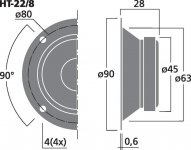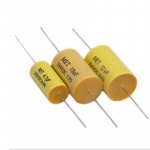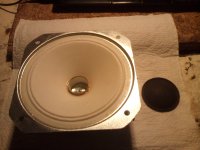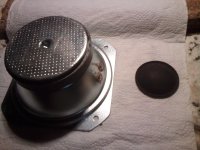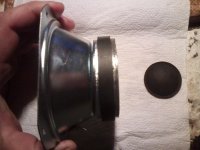@ JMF - Thanks for the back-up! I'm really trying to steer NewGuy towards the Monacor HT 22/8. The present mid/tweeter arrangement is really just for show, and a single tweeter can do the job of both (particularly obvious if you look at the series capacitor values!).
@ NewGuy - The time for crossover information will be when you decide on which option you are taking. Time is precious and we must stay focussed.
Hey! haha yeah I got that steering feeling and I don't mind it, I appreciate it
I do like the woodworking part but I will decide if I might do it either way I go after* I sort the speaker/crossover parts
Ah ok, I did not know about the "just for show" part I thought there was actually a point in what was originally done. How can I determine that from the capacitor (maybe you know a good link to learn a bit and read up on it)?
Ok, so then I will wait for the last people to reply to me, if its a negative response and I dont find another simple buy place, then I'll just go for the full range one that seems easy and straightforward to get.
Like I explained to JMFahey, even though I really liked that cheap and cheerful way, it's just taking too much time and effort to get the simple Monacor ones here... I'm gonna keep looking in the meantime but I'm defo not gonna deal with more of these "hard selling places". Basically, any store with no online price and simple ordering process=not getting them from there

So I'll let you know how that goes and post again later with an update before continuing

The mid (supplied by a 2.2uF cap) and the tweeter (supplied by a 1.0uF cap) are not well differentiated and are working in tandem in the high frequency range.
The combination can usefully be replaced by a single tweeter having a cone of similar size to that of the present mid - like the Monacor tweeter I suggested.
I regard the three-way arrangement on your speaker as simple window dressing - 'three drivers must be better than two' is probably what the manufacturers wanted the uninitiated buyer to think. This speaker is not real hi-fi - it is one designed to impress the average domestic consumer.
I'm surprised that it is difficult to order a tweeter from this Italian distributor: TWEETER CONICO,10 W, 8 OHM - Zzippgroup
The combination can usefully be replaced by a single tweeter having a cone of similar size to that of the present mid - like the Monacor tweeter I suggested.
I regard the three-way arrangement on your speaker as simple window dressing - 'three drivers must be better than two' is probably what the manufacturers wanted the uninitiated buyer to think. This speaker is not real hi-fi - it is one designed to impress the average domestic consumer.
I'm surprised that it is difficult to order a tweeter from this Italian distributor: TWEETER CONICO,10 W, 8 OHM - Zzippgroup
Some degree of research is needed before you can understand how crossovers work.(maybe you know a good link to learn a bit and read up on it)?
Your Sanyos have the most basic crossovers - just capacitors to block the low frequencies and allow only the high frequencies through to both the mid and tweeter.
You could start your research by reading the section on passive crossovers in this PDF:
http://peufeu.free.fr/audio/articles/Crossovers for Dummies.pdf
Beyond the information contained therein, things get much more complicated!
If you have easy access to Visaton drivers, then the TW 6 NG would fit into the tweeter aperture of your enclosure with a little coaxing.
TW 6 NG - 8 Ohm | Visaton
https://www.visaton.de/sites/default/files/dd_product/tw6ng_8.pdf
TW 6 NG - 8 Ohm | Visaton
https://www.visaton.de/sites/default/files/dd_product/tw6ng_8.pdf
The mid (supplied by a 2.2uF cap) and the tweeter (supplied by a 1.0uF cap) are not well differentiated and are working in tandem in the high frequency range.
The combination can usefully be replaced by a single tweeter having a cone of similar size to that of the present mid - like the Monacor tweeter I suggested.
I regard the three-way arrangement on your speaker as simple window dressing - 'three drivers must be better than two' is probably what the manufacturers wanted the uninitiated buyer to think. This speaker is not real hi-fi - it is one designed to impress the average domestic consumer.
I'm surprised that it is difficult to order a tweeter from this Italian distributor: TWEETER CONICO,10 W, 8 OHM - Zzippgroup
Thanks for the explanation! Ah ok I see, yeah I have read a bit about this window dressing, I just thought that being old kinda reduced the chances of that being the case, you know how back then all-stuff was made with higher standards. But yeah these did not look to be as neat as those oldies so I would not expect much of a review
About that zzipgroup, I dunno if its a geolocation limitation but I don't get a add to cart, it seems purely informational, I don't have VPN so I can't really check out if its a location thing, but it's not my browser for sure since I id basic troubleshooting and tried in my gf's pc too. It has a register section but it is for resellers only (asks company tax id info n' stuff), has a link for finding resellers in Italy (very few I have found so far sell monacor speakers), and the local resellers' sites have a "contact for price" website, 3 of which have basically dismissed me
But yeah, I am still going to look later today through some of those listed resellers to see if I find one with the tweeters you recommended (fingers crossed)

Some degree of research is needed before you can understand how crossovers work.
Your Sanyos have the most basic crossovers - just capacitors to block the low frequencies and allow only the high frequencies through to both the mid and tweeter.
You could start your research by reading the section on passive crossovers in this PDF:
http://peufeu.free.fr/audio/articles/Crossovers for Dummies.pdf
Beyond the information contained therein, things get much more complicated!
Cool thanks, it's on my night reading list
I found yesterday this youtube channel called "Kirby Meets Audio", seems to be newbie oriented. Do you know about it or have another one to recommend by any chance?
If you have easy access to Visaton drivers, then the TW 6 NG would fit into the tweeter aperture of your enclosure with a little coaxing.
TW 6 NG - 8 Ohm | Visaton
https://www.visaton.de/sites/default/files/dd_product/tw6ng_8.pdf
Ok gonna check that one out tonight too, thanks!
Last edited:
May I make a little plea? The forum rules ask you not to quote a previous post in its entirety, as doing so clutters up the thread. 
The Sanyos are far from classic speakers, but are good for experimenting on before you progress to renovating better quality ones.
Monacor International is based in Bremen, Germany. Perhaps you could deal with them direct? Go here: MONACOR: HT-22/8
I'm afraid I don't know about what's good or bad on the YouTube channels.
The Sanyos are far from classic speakers, but are good for experimenting on before you progress to renovating better quality ones.
Monacor International is based in Bremen, Germany. Perhaps you could deal with them direct? Go here: MONACOR: HT-22/8
I'm afraid I don't know about what's good or bad on the YouTube channels.
Oh sorry I didn't know that, I just included it to separate replies, but thanks for letting me know  I guess I just have to delete the "extra text" within the brackets and leave only the phrase I reply to right? (didn't wanna try it now cause if it doesn't work then I do what you pointed out I should not do
I guess I just have to delete the "extra text" within the brackets and leave only the phrase I reply to right? (didn't wanna try it now cause if it doesn't work then I do what you pointed out I should not do  )
)
Ok, that site says its only for B2B too but I already found a reseller from their reseller list that seems to ship here.. gonna check it out and update.
Ok, that site says its only for B2B too but I already found a reseller from their reseller list that seems to ship here.. gonna check it out and update.
Yes, just delete the unnecessary text within the quote brackets, taking care to leave the start and end quote brackets and their contents intact.I guess I just have to delete the "extra text" within the brackets and leave only the phrase I reply to right? (didn't wanna try it now cause if it doesn't work then I do what you pointed out I should not do)
Try it next time. I promise not to bite your head off if you get it wrong!
Trying it nowTry it next time.
.. the TW 6 NG would fit into the tweeter aperture of your enclosure with a little coaxing.
So I found a local site that has some visaton but not this one specifically. Can I ask, what info/specs should I compare to see if it fits? is it the cutout diameter only or can you estimate the fit from the cone size?
I ask cause the cutouts of this box does not have the trimmed edge that you see in better boxes, it's a flat cutout (I attach a pic at the bottom). So making the diameter bigger would not be an issue and could open the options.. I guess..
If that makes sense or is possible I found a tweeter with the same specs as you have recommended (monacor or visaton) but bigger diameter (i never heard of this brand so i hope its good enough):
Dynavox: DX159 25mm Hochtoner
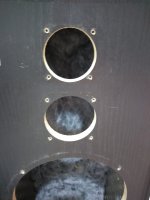
Last edited:
I really shouldn't have to tutor you on how to choose a tweeter whose dimensions suit your aperture, but I'll give it a go - life's a challenge anyway!Can I ask, what info/specs should I compare to see if it fits? is it the cutout diameter only or can you estimate the fit from the cone size?
Look at the attachment. See how the 63mm dimension means the back of tweeter will fit into your mid aperture? See how the 90mm dimension will stop the entire tweeter from falling into the aperture? See how the 80mm screw fixing circle diameter means that the screws will go into wood and not thin air?
Perhaps you can now tell me if the Dynavox will fit, as I can't read German!
It's difficult to make a circular aperture substantially larger. If it just needs to be a little larger, you can achieve this with a curved file.
Attachments
Last edited:
Hey!
hahaha I see what you meant about the tutoring and fit but that's my bad because I missed a piece of information, that question was more meant for a speaker that did not have the cutout graph or spec listed, so I was wondering about what other info I needed. But thanks
but that's my bad because I missed a piece of information, that question was more meant for a speaker that did not have the cutout graph or spec listed, so I was wondering about what other info I needed. But thanks  Oh and yeah the ones I sent you have a "Hole circle cutout: approx. 90 mm" (that's what Google translate translated), so a big no
Oh and yeah the ones I sent you have a "Hole circle cutout: approx. 90 mm" (that's what Google translate translated), so a big no 
Btw is there much difference between dome and cone tweeters (provided I find a good size and similar specs), specifically for this project? It seems they sell more dome tweeters here than the others. Also the dome ones look cool (don't think that's a valid point though lol)
I'm going to a shopping center closeby today where there is supposed to be a component store, maybe I can find something along the lines of the monacor you suggested. Plus I'll do a little box filling experiment for the extra hole to see how it ends up.. I'll let you know later how it goes with both
hahaha I see what you meant about the tutoring and fit
Btw is there much difference between dome and cone tweeters (provided I find a good size and similar specs), specifically for this project? It seems they sell more dome tweeters here than the others. Also the dome ones look cool (don't think that's a valid point though lol)
I'm going to a shopping center closeby today where there is supposed to be a component store, maybe I can find something along the lines of the monacor you suggested. Plus I'll do a little box filling experiment for the extra hole to see how it ends up.. I'll let you know later how it goes with both
Long ago cone tweeters were all that was available, so everybody used them, what else?
Even the "best" speakers around, think Marantz, Altec, KLH, Advent, early AR, even JBL!!!!!
Then domes swept the market and cone ones were forgotten, except some terrible ones in cheap speakers (like ... um ... what you found ) but now many are rediscovering them, at least to repair old cabinets kept in storage, gotten for peanuts at Salvation Army or even free.
Domes are technically better because they reach higher flatter but need higher crossover frequencies; fine in a 2 way with, say, a 6" or 8" woofer which reaches higher so as to meet the tweeter, but if woofer is larger or heavier, you have a hole in the middle which generally needs its own mid speaker.
While a cone tweeter which is actually a "light small speaker" reaches way down and can easily be mated to "any" woofer.
As Galu said, given your "mystery" woofer , a cone tweeter will integrate better with it, replacing *both* mid and tweet.
The low cost and ease of mounting is a bonus.
FWIW, I make my own speakers, and after many years I made cone tweeters again.
I am into Musical Instrument amplification and needed a LOUD tweeter, reaching as low as possible and biampable taking a lot of power, this is the end result.
4" cone, large (for a tweeter) high power 19mm voice coil which takes 35/40W RMS, I am talking 35/40W **at the tweeter voice coil** , system power can be as high as 500W RMS, intended use is slapping Bass players, Keyboard amps, and compact PA systems, without needing to resort to a horn + driver combination .
Huge (for a Tweeter) magnet: 73 mm diameter , some 4 or 5 times as heavy the Monacor or Goldwood one.
Even the "best" speakers around, think Marantz, Altec, KLH, Advent, early AR, even JBL!!!!!
Then domes swept the market and cone ones were forgotten, except some terrible ones in cheap speakers (like ... um ... what you found ) but now many are rediscovering them, at least to repair old cabinets kept in storage, gotten for peanuts at Salvation Army or even free.
Domes are technically better because they reach higher flatter but need higher crossover frequencies; fine in a 2 way with, say, a 6" or 8" woofer which reaches higher so as to meet the tweeter, but if woofer is larger or heavier, you have a hole in the middle which generally needs its own mid speaker.
While a cone tweeter which is actually a "light small speaker" reaches way down and can easily be mated to "any" woofer.
As Galu said, given your "mystery" woofer , a cone tweeter will integrate better with it, replacing *both* mid and tweet.
The low cost and ease of mounting is a bonus.
FWIW, I make my own speakers, and after many years I made cone tweeters again.
I am into Musical Instrument amplification and needed a LOUD tweeter, reaching as low as possible and biampable taking a lot of power, this is the end result.
4" cone, large (for a tweeter) high power 19mm voice coil which takes 35/40W RMS, I am talking 35/40W **at the tweeter voice coil** , system power can be as high as 500W RMS, intended use is slapping Bass players, Keyboard amps, and compact PA systems, without needing to resort to a horn + driver combination .
Huge (for a Tweeter) magnet: 73 mm diameter , some 4 or 5 times as heavy the Monacor or Goldwood one.
Attachments
Domes are technically better because they reach higher flatter but need higher crossover frequencies; fine in a 2 way with, say, a 6" or 8" woofer which reaches higher so as to meet the tweeter, but if woofer is larger or heavier, you have a hole in the middle which generally needs its own mid speaker.
While a cone tweeter which is actually a "light small speaker" reaches way down and can easily be mated to "any" woofer.
As Galu said, given your "mystery" woofer, a cone tweeter will integrate better with it, replacing *both* mid and tweet.
The low cost and ease of mounting is a bonus.
Hey JMFahey! Since you put it that way of cones reaching lower to match my "mystery" woofer it makes sense; Im guessing that is why Galu chose the monacor that goes down to 1kHz and then (i guess) the capacitor he recommended makes a cut off (or rolloff, sorry i dont know whats the term) at 3.5 kHz.. at least from what I have read that 3.5 seems to be like a standard/recommended point.
Thanks a lot for the explanation of the why I see domes more than cones and why cones are better for me
Frankly, I was almost losing the will to live as you brought yet another variable (the dome tweeter) into the equation.
hahahaha So sorry man I didn't mean to abuse your patience
I honestly just asked out of ignorance and curiosity. It's all I saw around here and I admit they look cool, but hey at least I learned something new for my next* adventure


I wonder what you found in the store today?
Yeah, sorry I went out for dinner afterwards and returned late. But yeah all I saw there were domes, and expensive ones, they upgraded to more of a hi-fi store. But I asked the guy for similar to the monacor ones and he recommend a small old electronics store quite close to my place (it was not in google so I did not technically exist for me
Everything is closed today here so I will go tomorrow to check it out

If I see those capacitors you mentioned, how many should I get, and are there more components I should get? I'm not sure what's the plan with the crossover and how its gonna get hooked up, so if I should hold my horses with buying stuff just say the word!
Last edited:
Provided you get a large cone tweeter, like the Monacor I have recommended, we can use a simple first-order, high-pass crossover on the tweeter.
This consists of a single capacitor - so you'll need to buy two capacitors, one for each tweeter.
A first order crossover allows the tweeter to operate substantially below the theoretical crossover point, as the roll-off below the theoretical crossover frequency is a shallow 6dB/octave.
The capacitor value is chosen so that the response will be 12dB down at the resonant frequency of the tweeter which is 1500Hz in the case of the Monacor tweeter recommended. This requires a capacitor of stock value 3.3uF, which must be a non-polar (NP) electrolytic type or, preferably, a polypropylene type.
look at the first order crossover calculator here: High-pass filter 6dB per octave.
Now, there are higher order crossovers, but they are not necessary in this case. We can simply retain the Sanyo's original design intention of a first order crossover.
If the tweeter turns out to be too loud compared to the woofer, we would add an attenuating circuit known as an L-pad between the capacitor and the tweeter.
The amount of attenuation is measured in dB and we can only guess at how much is required as we don't know the sensitivity of the woofer (the sensitivity of the Monacor tweeter is 91dB).
Here is an L pad calculator: L pad calculator - attenuation dB damping impedance decibel loudspeaker speaker voltage divider - sengpielaudio Sengpiel Berlin
At a guess, you may need 3dB of attenuation, requiring resistors of stock value 2.2 ohm and 22 ohm. These must be ceramic (wire-wound) types of power rating 5 to 10W.
I hope the above information will alert you fully to the plan!
This consists of a single capacitor - so you'll need to buy two capacitors, one for each tweeter.
A first order crossover allows the tweeter to operate substantially below the theoretical crossover point, as the roll-off below the theoretical crossover frequency is a shallow 6dB/octave.
The capacitor value is chosen so that the response will be 12dB down at the resonant frequency of the tweeter which is 1500Hz in the case of the Monacor tweeter recommended. This requires a capacitor of stock value 3.3uF, which must be a non-polar (NP) electrolytic type or, preferably, a polypropylene type.
look at the first order crossover calculator here: High-pass filter 6dB per octave.
Now, there are higher order crossovers, but they are not necessary in this case. We can simply retain the Sanyo's original design intention of a first order crossover.
If the tweeter turns out to be too loud compared to the woofer, we would add an attenuating circuit known as an L-pad between the capacitor and the tweeter.
The amount of attenuation is measured in dB and we can only guess at how much is required as we don't know the sensitivity of the woofer (the sensitivity of the Monacor tweeter is 91dB).
Here is an L pad calculator: L pad calculator - attenuation dB damping impedance decibel loudspeaker speaker voltage divider - sengpielaudio Sengpiel Berlin
At a guess, you may need 3dB of attenuation, requiring resistors of stock value 2.2 ohm and 22 ohm. These must be ceramic (wire-wound) types of power rating 5 to 10W.
I hope the above information will alert you fully to the plan!
If all that sounds too complicated, a simpler alternative (assuming we've got the degree of attenuation right) is to put a 2.2uF capacitor and a 3.3 ohm resistor in series with the 8 ohm tweeter.
That would be easier for you to wire (and you currently have a 2.2uF capacitor in your Sanyo to experiment with until you get a polypropylene one).
So, the minimum purchase required to get you going is - two large cone tweeters and two 3.3 ohm ceramic resistors.
What could be simpler than that!
That would be easier for you to wire (and you currently have a 2.2uF capacitor in your Sanyo to experiment with until you get a polypropylene one).
So, the minimum purchase required to get you going is - two large cone tweeters and two 3.3 ohm ceramic resistors.
What could be simpler than that!
I like the first plan. Even if it's complicated I might learn more from that process 
So for the first plan I should look for 2 of these: "capacitor of stock value 3.3uF, which must be a non-polar (NP) electrolytic type or, preferably, a polypropylene type."?
If I understood correctly for the moment nothing else until I listen to the result right?
So for the first plan I should look for 2 of these: "capacitor of stock value 3.3uF, which must be a non-polar (NP) electrolytic type or, preferably, a polypropylene type."?
If I understood correctly for the moment nothing else until I listen to the result right?
Ceramic resistors are not too expensive and you may want to stock up with a few if you get the chance.
But you're correct, only after listening will you know if the tweeter needs attenuating and, if so, by how much.
I advise a 3.3uF polypropylene or other type of film resistor - not an NP electrolytic like the ones originally fitted in your Sanyos.
Of course all this hangs on your purchase of large cone tweeters!
But you're correct, only after listening will you know if the tweeter needs attenuating and, if so, by how much.
I advise a 3.3uF polypropylene or other type of film resistor - not an NP electrolytic like the ones originally fitted in your Sanyos.
Of course all this hangs on your purchase of large cone tweeters!
- Status
- This old topic is closed. If you want to reopen this topic, contact a moderator using the "Report Post" button.
- Home
- Design & Build
- Construction Tips
- Help needed to Fix or Repurpose old Speakers
